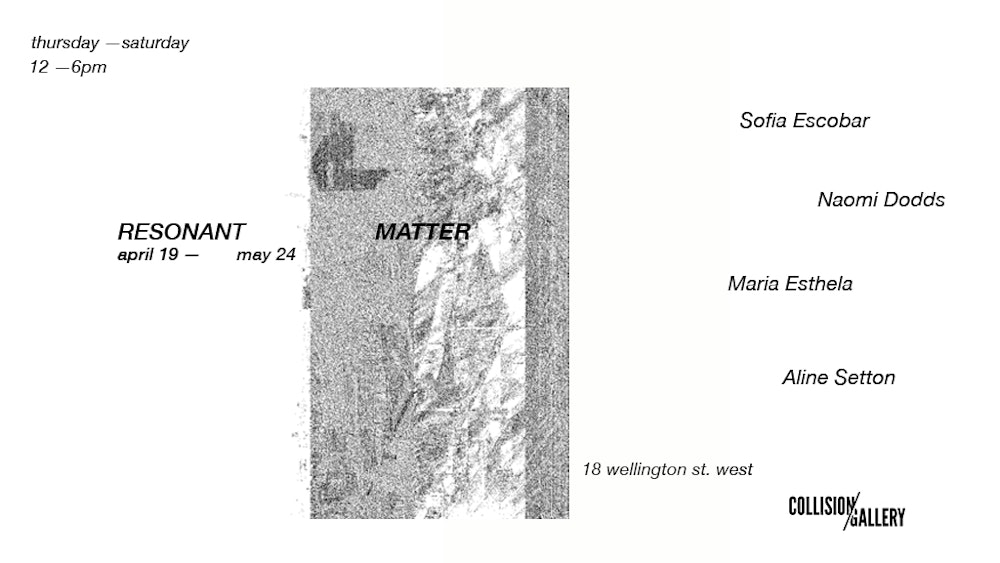

Resonant Matter

“How does distance look?” is a simple direct question. It extends from a spaceless
within to the edge
of what can be loved.”
-Anne Carson, Autobiography of Red
How does distance look? Is it the manifestation of an echo? Does it get weighed down by gravity? Is it obscured by shadow? Or fragmented by perception? There are, perhaps, no clear answers to the question of distance. In Resonant Matter, artists Naomi Dodds, Sofia Escobar, Maria Esthela, and Aline Setton venture into the threshold between places and report back what’s there. The works in this exhibition explore how migration, memory, and materiality converge through abstraction, light, and site, emphasizing the artists’ shared histories of migration to, from, and within Canada.
Influenced in various ways by the Light and Space movement, each artist approaches a visual description of distance through fragmented shifts in light, shadow, sound, and movement—foregrounding the body’s relationship to its environment. The artworks trace how personal histories of migration and cultural dislocation surface not through direct representation, but through an engagement with tension: between material and metaphor, weight and lightness, concealment and revelation.
Dodds’s sculptural installation Nine Ladies revisits the Nine Ladies stone circle in Derbyshire, UK, a Bronze Age site traditionally believed to depict nine ladies turned to stone as a penalty for dancing on the Sabbath. Through cast aluminum forms and a layered soundscape of interviews with local women, the work reframes the myth through a contemporary feminist lens by considering how distance can sharpen historical consciousness and how oral traditions persist alongside cultural and geological deep time. The stone women recount the fatal night they became petrified, reflecting on collective experiences of misogyny and shame while navigating the intersections of history, myth, and contemporary modes of information sharing.
Working with aircraft cable and paracord, Escobar adapts Andean textile traditions into illusory sculptural forms that consist of a single symmetrical element repeated to produce a continuous rhythmic line. Using aircraft cable—typically associated with architecture—Double Loom teeters between traditional weaving practices and modern industry, reflecting the adaptability inherent in the process of resettlement. Form & Matter reimagines the vase form, typically associated with ceramic traditions, using paracord to weave a ghostly impression of an endless column of diamonds and cylinders. Unlike a vase, the work can hold only light and shadow, resisting solidity.
Maria Esthela’s site-specific installations approach migration as both a natural phenomenon and social condition. 815 (Birds in Space) extends from artworks of an almost identical name by Constantin Brancusi and Liz Larner respectively, pluralizing the pieces from the vantage point of a combined perspective. Like Larner from Brancusi, Maria Esthela’s intricate copper work builds upon a shifting form that appears to be taking off and dissipating in the air, much like the movements of birds or monarch butterflies during migration. In M4C (Mother and Child), the artist activates a neglected corner of the gallery to reflect the immigrant experience of seeking refuge and transforming overlooked or unwanted spaces into sites of adaptation.
In If I could hold all the pieces, a suite of seven acrylic paintings, Setton explores the emotional landscape of resettlement. Some works depict familiar spaces—like the Toronto Reference Library, a site of early comfort—while others dissolve into abstraction: waves, stone, perhaps distant planets. Together, they form a fragmented collage of belonging across geographies. Architectural elements, including custom easels inspired by Lina Bo Bardi, frame the paintings as structural objects. These sculptural supports choreograph the viewer’s movement through the gallery, echoing the artist’s own negotiation of place, memory, and the subtle shifts in how we learn to inhabit the world.
Resonant Matter reminds us that the impact of migration often lives in the unnoticed details: the shape of a stairwell, the feel of a woven line, the way sound bounces off a wall. Taken as a whole, the works in this exhibition draw our attention to the subtle ways that new environments are absorbed, negotiated, and remembered.
- Erin Storus